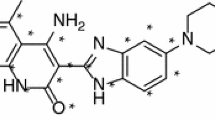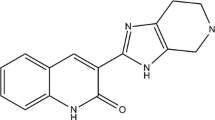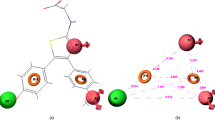Abstract
GPR35, an orphan G protein-coupled receptor, has attracted much attention as a novel therapeutic target for the treatment of diabetes, hypertension, etc. Recently, 8-substituted chromen-4-one-2-carboxylic acid derivatives were identified as potent and selective agonists for human GPR35. In the present study, the three-dimensional quantitative structure–activity relationship (3D-QSAR) models were developed for a series of 8-substituted chromen-4-one-2-carboxylic acid derivatives using comparative molecular field analysis (CoMFA), comparative molecular similarity indices analysis (CoMSIA), and Topomer CoMFA techniques implemented in the SYBYL software packages. The statistically significant models were obtained with 30 compounds in training set by ligand-based atom-by-atom matching alignment, which were further validated by a test set of eight compounds. The CoMFA model resulted in cross-validated coefficient (q 2) value of 0.610 using 4 components, non-cross-validated coefficient (r 2) value of 0.918 with estimated F value of 69.917, and standard error of estimate (SEE) of 0.352. While the CoMSIA model combined with steric, electrostatic and hydrophobic fields were finally selected (q 2 = 0.646, r 2 = 0.800, F = 53.852, SEE = 0.489, N = 2). For the Topomer CoMFA model, the better statistics were obtained based on fragment units (q 2 = 0.746, r 2 = 0.979, F = 146.294, SEE = 0.175, N = 7). Furthermore, the contour maps obtained from 3D-QSAR studies were appraised for activity trends for the compounds analyzed. The results indicate that steric, electrostatic, and hydrophobic substituents play a significant role in the agonist activity. The data generated from the present study will further help design novel, potent, and selective agonists for GPR35.







Similar content being viewed by others
Abbreviations
- 3D-QSAR:
-
Three-dimensional quantitative structure–activity relationship methods
- CoMFA:
-
Comparative molecular field analysis
- CoMSIA:
-
Comparative molecular similarity indices analysis
- GPCRs:
-
G protein-coupled receptors
- GPR35:
-
G protein-coupled receptor 35
- LOO:
-
Leave-one-out procedure
- L5O:
-
Leave-five-out procedure
- N :
-
Optimal number of components
- PLS:
-
Partial least square method
- PRESS:
-
Predictive sum of squares
- q 2 :
-
The cross-validated correlation coefficient
- q 2L5O :
-
Cross-validated correlation coefficient for leave-five-out
- r 2 :
-
Non-cross-validated correlation coefficient
- SEE:
-
Standard error of estimate
References
Chandrasekaran V, McGaughey GB, Cavallito CJ, Bowen JP (2004) Three-dimensional quantitative structure–activity relationship (3D-QSAR) analyses of choline acetyltransferase inhibitors. J Mol Graph Model 23:69–76
Cho SJ, Tropsha A (1995) Cross-validated R2-guided region selection for comparative molecular field analysis: a simple method to achieve consistent results. J Med Chem 38:1060–1066
Clark M, Cramer RD, Vanopdenbosch N (1989) Validation of the general-purpose tripos 5.2 force-field. J Comput Chem 10:982–1012
Cosi C, Mannaioni G, Cozzi A, Carla V, Sili M, Cavone L, Maratea D, Moroni F (2011) G-protein coupled receptor 35 (GPR35) activation and inflammatory pain: studies on the antinociceptive effects of kynurenic acid and zaprinast. Neuropharmacology 60:1227–1231
Cramer RD (2012) R-group template CoMFA combines benefits of “ad hoc” and topomer alignments using 3D-QSAR for lead optimization. J Comput Aided Mol Des 26:805–819
Ding W, Sun M, Luo S, Xu T, Cao Y, Yan X, Wang Y (2013) A 3D QSAR study of betulinic acid derivatives as anti-tumor agents using topomer CoMFA: model building studies and experimental verification. Molecules 18:10228–10241
Funke M, Thimm D, Schiedel AC, Müller CE (2013) 8-Benzamidochromen-4-one-2-carboxylic acids: potent and selective agonists for the orphan G protein-coupled receptor GPR35. J Med Chem 56:5182–5197
Heikamp K, Bajorath J (2013) The future of virtual compound screening. Chem Biol Drug Des 81:33–40
Jenkins L, Alvarez-Curto E, Campbell K, de Munnik S, Canals M, Schlyer S, Milligan G (2011) Agonist activation of the G protein-coupled receptor GPR35 involves transmembrane domain III and is transduced via Gα13 and β-arrestin-2. Br J Pharmacol 162:733–748
Klebe G, Abraham U, Mietzner T (1994) Molecular similarity indices in a comparative analysis (CoMSIA) of drug molecules to correlate and predict their biological activity. J Med Chem 37:4130–4146
Mackenzie AE, Lappin JE, Taylor DL, Nicklin SA, Milligan G (2011) GPR35 as a novel therapeutic target. Front Endocrinol (Lausanne) 2:1–10
Milligan G (2002) Strategies to identify ligands for orphan G-protein-coupled receptors. Biochem Soc Trans 30:789–793
Min KD, Asakura M, Nakamaru K, Liao Y, Okazaki H, Takahashi T, Fujimoto K, Ito S, Takahashi A, Asanuma H, Yamazaki S, Minamino T, Sanada S, Seguchi O, Nakano A, Ando Y, Otsuka T, Furukawa H, Isomura T, Takashima S, Mochizuki N, Kitakaze M (2010) Identification of genes related to heart failure using global gene expression profiling of human failing myocardium. Biochem Biophys Res Commun 393:55–60
Neetoo-Isseljee Z, Mackenzie AE, Southern C, Jerman J, McIver EG, Harries N, Taylor DL, Milligan G (2013) High-throughput identification and characterization of novel, species-selective GPR35 agonists. J Pharmacol Exp Ther 344:568–578
Ohshiro H, Tonai-Kachi H, Ichikawa K (2008) GPR35 is a functional receptor in rat dorsal root ganglion neurons. Biochem Biophys Res Commun 365:344–348
Pal K, Melcher K, Xu HE (2012) Structure and mechanism for recognition of peptide hormones by Class B G-protein-coupled receptors. Acta Pharmacol Sin 33:300–311
Taniguchi Y, Tonai-Kachi H, Shinjo K (2006) Zaprinast, a well-known cyclic guanosine monophosphate-specific phosphodiesterase inhibitor, is an agonist for GPR35. FEBS Lett 580:5003–5008
Thimm D, Funke M, Meyer A, Müller CE (2013) 6-Bromo-8-(4-[(3)H]methoxybenzamido)-4-oxo-4H-chromene-2-carboxylic acid: a powerful tool for studying orphan G protein-coupled receptor GPR35. J Med Chem 56:7084–7099
Wang J, Simonavicius N, Wu X, Swaminath G, Reagan J, Tian H, Ling L (2006) Kynurenic acid as a ligand for orphan G protein-coupled receptor GPR35. J Biol Chem 281:22021–22028
Wang H, Du Z, Zhang C, Tang Z, He Y, Zhang Q, Zhao J, Zheng X (2014) Biological evaluation and 3D-QSAR studies of curcumin analogues as aldehyde dehydrogenase 1 inhibitors. Int J Mol Sci 15:8795–8807
Wilson GL, Lill MA (2011) Integrating structure-based and ligand-based approaches for computational drug design. Future Med Chem 3:735–750
Yang Y, Lu JY, Wu X, Summer S, Whoriskey J, Saris C, Reagan JD (2010) G-protein-coupled receptor 35 is a target of the asthma drugs cromolyn disodium and nedocromil sodium. Pharmacology 86:1–5
Acknowledgments
The authors would like to acknowledge the financial supports from the National Natural Science Foundation of China (No. 81101687), the “Innovative Drug Development” State Key Science and Technology of China (No. 2009ZX09103-104), Program for the Top Science and Technology Innovation Teams of Higher Learning Institutions of Shanxi Province, and the Technology Innovation Team of Shanxi Province.
Conflict of interest
The author declares that there are no conflicts of interest.
Author information
Authors and Affiliations
Corresponding author
Additional information
Taigang Liang and Chaoqun Yan have contributed equally to this work.
Rights and permissions
About this article
Cite this article
Liang, T., Yan, C., Yang, L. et al. 3D-QSAR studies of 8-substituted chromen-4-one-2-carboxylic acid derivatives as potent agonists for the orphan G protein-coupled receptor 35. Med Chem Res 24, 2183–2194 (2015). https://doi.org/10.1007/s00044-014-1287-3
Received:
Accepted:
Published:
Issue Date:
DOI: https://doi.org/10.1007/s00044-014-1287-3




